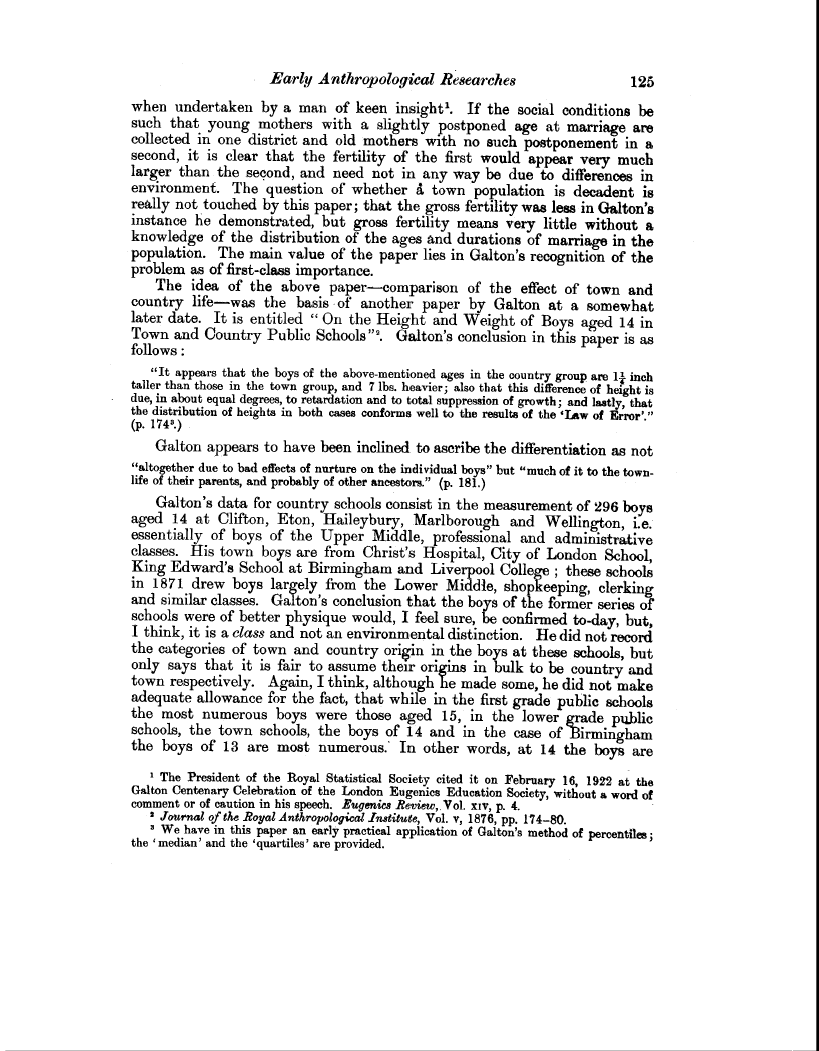Early Anthropological Researches 125
when undertaken by a man of keen insight'. If the social conditions be such that young mothers with a slightly postponed age at marriage are collected in one district and old mothers with no such postponement in a second, it is clear that the fertility of the first would appear very much larger than the second, and need not in any way be due to differences in environment. The question of whether a town population is decadent is really not touched by this paper; that the gross fertility was less in Galton's instance he demonstrated, but gross fertility means very little without a knowledge of the distribution of the ages and durations of marriage in the population. The main value of the paper lies in Galton's recognition of the problem as of first-class importance.
The idea of the above paper-comparison of the effect of town and country life-was the basis of another paper by Galton at a somewhat later date. It is entitled " On the Height and Weight of Boys aged 14 in Town and Country Public Schools ". Galton's conclusion in this paper is as follows
"It appears that the boys of the above-mentioned ages in the country group are I- It taller than those in the town group, and 7 lbs. heavier; also that this difference of height is
due, in about equal degrees, to retardation and to total suppression of growth; and lastly, that the distribution of heights in both cases conforms well to the results of the 'Law of Error'."
(p. 1743.)
Galton appears to have been inclined to ascribe the differentiation as not
"altogether due to bad effects of nurture on the individual boys" but "much of it to the townlife of their parents, and probably of other ancestors." (p. 181.)
Galton's data for country schools consist in the measurement of 296 boys aged 14 at Clifton, Eton, Haileybury, Marlborough and Wellington, i.e. essentially of boys of the Upper Middle, professional and administrative classes. His town boys are from Christ's Hospital, City of London School, King Edward's School at Birmingham and Liverpool College , these schools in 1871 drew boys largely from the Lower Middle, shopkeeping, clerking and similar classes. Galton's conclusion that the boys of the former series of schools were of better physique would, I feel sure, be confirmed to-day, but, I think, it is a class and not an environmental distinction. He did not record the categories of town and country origin in the boys at these schools, but only says that it is fair to assume their origms in bulk to be country and town respectively. Again, I think, although he made some, he did not make adequate allowance for the fact, that while in the first grade public schools the most numerous boys were those aged 15, in the lowergr ade public schools, the town schools, the boys of 14 and in the case of Birmingham the boys of 13 are most numerous. In other words, at 14 the boys are
' The President of the Royal Statistical Society cited it on February 16, 1922 at the Galton Centenary Celebration of the London Eugenics Education Society, without a word of comment or of caution in his speech. Eugenics Review,,Vol. xiv, p. 4.
2 Journal of the Royal Anthropological Institute, Vol. V, 1876, pp. 174-80.
3 We have in this paper an early practical application of Galton's method of percentiles; the ' median' and the 'quartiles' are provided.

